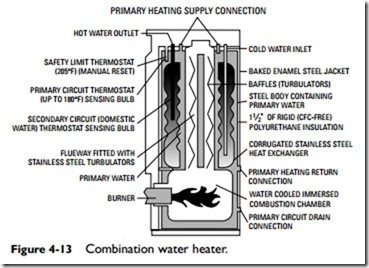Heat Pump Water Heaters
A heat pump water heater consists of a small electrically operated compressor, the heat pump and domestic water supply controls, and a water storage tank (see Figure 4-12). It uses the heat of the air in the room and the energy used to operate its compressor to heat the water in its storage tank. Unlike conventional gas-fired or electric resistance water heaters, the heat pump water heater does not create heat. It transfers heat from one point to another. It is essentially a small heat pump that uses the room air as the heat source and the water in the storage tank as the heat sink. Because it is a heat pump, it can also cool the air and dehumidify it.
In some heat pump water heater installations, the heat pump and water storage tank are separate. A water pump and piping flow loop are used to circulate the water between the heat pump water heater and the water storage tank. The water is heated in the heat pump water heater and stored in the tank.
The principal advantage of using a heat pump water heater with a separate water tank is that either can be replaced independently of the other when they malfunction. Another important advantage is their location flexibility.
The heat pump water heater may also be an integral part of the water storage tank. In these installations, there is no need for a water pump or flow loop. This arrangement also eliminates energy loss from the flow loop piping or the need for freeze protection.
Heat pump water heaters are more expensive to purchase and install than conventional electric resistance water heaters. On the other hand, they use 50 percent less energy than conventional electric resistance heaters.
Combination Water Heaters
Many of the earlier combination water/space heaters used in hydronic systems did not keep the domestic hot water separated from the hot water used for space heating. This feature resulted in scale buildup in the water tank and oxygen-induced damage to the tubing in the radiant heating panel. A combination water heater in which the domestic hot water is separated from the space heating water in the same appliance is shown in Figure 4-13. Two separate corrugated stainless steel tanks are used in this design. The outer tank contains the primary fluid (water) and is connected to the space-heating circuit. The inner tank contains the domestic hot water and is connected directly to the utility water supply and a separate domestic hot-water circuit. The primary water in the outer tank is heated by a gas or oil burner and does not exceed a temper- ature of 180ºF, which significantly reduces scale buildup in the domestic (that is, inner) hot-water tank. The domestic hot-water supply in the inner tank absorbs heat from the hot water in the outer tank. There is no direct heating of the inner tank.
The two water circulation circuits supplied by this type of com- bination water heater are completely independent of one another.
This arrangement eliminates the problem of oxygen from hot domestic water mingling with the space-heating water, thereby reducing the possibility of oxygen production, which can damage tubing or cause scale buildup in the tank.
Note
The primary water in the outer tank is never changed. Changing the water can lead to the introduction of oxygen into the system.
The space-heating water in the outer tank is circulated in a closed loop through baseboards, tubing or panels, and heat exchangers. The only point of contact between the inner and outer tanks is where the cold-water inlet pipe and the hot-water flow pipe extend through the top of the combination water heater. The heater is equipped with two separate built-in control systems, one for the outer tank and one for the inner tank.
Some combination water heater installations consist of an indirect water heater connected to a high efficiency furnace or a boiler. Liquid heat (from the hot water) is transferred to the air and then distributed through a duct system by a blower.
Note
Combination water heaters are practical mostly in new construction or where a boiler or furnace must be replaced.

